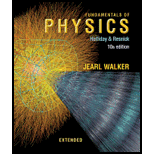
Concept explainers
To rank:
The waves according to
a) their wave speed
b) the tension in the string along which they travel
Answer to Problem 1Q
Solution:
a) The waves can be ranked according to their wave speed as
b) The waves can be ranked according to their tension in the string along which they travel as
Explanation of Solution
1) Concept:
We can use the concept of the equation of transverse wave and speed of a travelling wave. The wave speed on a stretched string gives the relation between speed and tension in the string.
2) Formulae:
i)
ii)
iii)
3) Given:
The four waves along the strings with the same linear densities are
i)
ii)
iii)
iv)
4) Calculations:
a) Rank the waves according to their wave speed :
The equation of transverse wave is
The speed of the travelling wave is
The equation (i),
Compare this equation with equation (1), then the speed of the travelling wave is
The equation (ii) is
Compare this equation with equation (1), then the speed of the travelling wave is
The equation (iii) is
Compare this equation with equation (1), then the speed of the travelling wave is
The equation (iv) is
Compare this equation with equation (1), then the speed of the travelling wave is
Hence, the rank of the waves according to the wave speed is
b) Rank the waves according to tension:
The wave speed on a stretched string is
The speed on the stretched string is directly proportional to the tension in the string with the same linear density.
The speed on the stretched string for equation (i) is
The speed on the stretched string for equation (ii) is
The speed on the stretched string for equation (iii) is
The speed on the stretched string for equation (i) is
Hence, the rank of the waves according to their tension is
Conclusion:
We can find the wave speed by using its expression and rank their values. By using the expression of the speed on the stretched string, we can find thetension in each string and rank their values.
Want to see more full solutions like this?
Chapter 16 Solutions
Fundamentals of Physics Extended
- 6. As the distance between two charges decreases, the magnitude of the electric potential energy of the two-charge system: a) Always increases b) Always decreases c) Increases if the charges have the same sign, decreases if they have the opposite signs d) Increases if the charges have the opposite sign, decreases if they have the same sign 7. To analyze the motion of an elastic collision between two charged particles we use conservation of & a) Energy, Velocity b) Momentum, Force c) Mass, Momentum d) Energy, Momentum e) Kinetic Energy, Potential Energyarrow_forwardpls help on all asked questions kindlyarrow_forwardpls help on all asked questions kindlyarrow_forward
- 17. Two charges, one of charge +2.5 × 10-5 C and the other of charge +3.7 × 10-6 C, are 25.0 cm apart. The +2.5 × 10−5 C charge is to the left of the +3.7 × 10−6 C charge. a. Draw a diagram showing the point charges and label a point Y that is 20.0 cm to the left of the +3.7 × 10-6 C charge, on the line connecting the charges. (Field lines do not need to be drawn.) b. Calculate the net electric field at point Y.arrow_forward3arrow_forwardSet ба ||Axl 49.32 6b 71 Ay 22 Magnitude of A Angle of A 24.04 Angle of -A 22 54 155.96 ° (pos Ax) 204.04 ° (neg Ax) 335.96 ° (pos Ax) ° (neg Ax) 115.77 ° (pos Ax) 295.77 ° (pos Ax) -39 81 208.78 ° (neg Ax) 28.78 ° (neg Ax)arrow_forward
 Physics for Scientists and Engineers: Foundations...PhysicsISBN:9781133939146Author:Katz, Debora M.Publisher:Cengage Learning
Physics for Scientists and Engineers: Foundations...PhysicsISBN:9781133939146Author:Katz, Debora M.Publisher:Cengage Learning University Physics Volume 1PhysicsISBN:9781938168277Author:William Moebs, Samuel J. Ling, Jeff SannyPublisher:OpenStax - Rice University
University Physics Volume 1PhysicsISBN:9781938168277Author:William Moebs, Samuel J. Ling, Jeff SannyPublisher:OpenStax - Rice University Principles of Physics: A Calculus-Based TextPhysicsISBN:9781133104261Author:Raymond A. Serway, John W. JewettPublisher:Cengage Learning
Principles of Physics: A Calculus-Based TextPhysicsISBN:9781133104261Author:Raymond A. Serway, John W. JewettPublisher:Cengage Learning Physics for Scientists and Engineers, Technology ...PhysicsISBN:9781305116399Author:Raymond A. Serway, John W. JewettPublisher:Cengage Learning
Physics for Scientists and Engineers, Technology ...PhysicsISBN:9781305116399Author:Raymond A. Serway, John W. JewettPublisher:Cengage Learning Physics for Scientists and EngineersPhysicsISBN:9781337553278Author:Raymond A. Serway, John W. JewettPublisher:Cengage Learning
Physics for Scientists and EngineersPhysicsISBN:9781337553278Author:Raymond A. Serway, John W. JewettPublisher:Cengage Learning Physics for Scientists and Engineers with Modern ...PhysicsISBN:9781337553292Author:Raymond A. Serway, John W. JewettPublisher:Cengage Learning
Physics for Scientists and Engineers with Modern ...PhysicsISBN:9781337553292Author:Raymond A. Serway, John W. JewettPublisher:Cengage Learning





